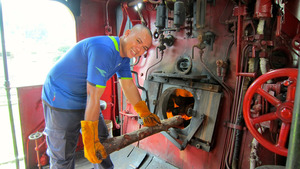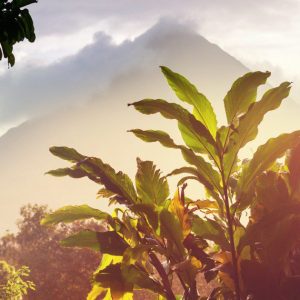This is the eighth in a series of blogs that describes our continued travels on the Malaysia Peninsular and the Malaysian portion of Borneo.
Full steam ahead
 There seems to have been more interest than ever in steam trains in the UK. TV programmes and the 75th anniversary of the Mallard’s record run has fueled the interest. So we were delighted to include The North Borneo Steam Railway in our travel plans. With its origins in the 1880s and established in 1914, a more recent collaboration between Sutera Harbour Resort and the Sabah State Railway allowed us to see more of Sabah and at the same time experience the bygone age of the steam locomotive.
There seems to have been more interest than ever in steam trains in the UK. TV programmes and the 75th anniversary of the Mallard’s record run has fueled the interest. So we were delighted to include The North Borneo Steam Railway in our travel plans. With its origins in the 1880s and established in 1914, a more recent collaboration between Sutera Harbour Resort and the Sabah State Railway allowed us to see more of Sabah and at the same time experience the bygone age of the steam locomotive.
Transport to Tanjung Aru station is included if you are staying at Sutera Harbour and a walk along the platform gets us our first glimpse of the 85 tons British Vulcan that will be pulling this service. Built by the Vulcan Foundry in Newton-le-Willows in1954, it was decommissioned from general use in the early 70s but was relaunched in 2000 in honour of Kota Kinabalu achieving city status. The engine is now called Kota Kinabalu City. Childlike enthusiasm blagged me and my SilverTravel bag a trip onto the hot plate to watch the stoker load logs into the furnace (unusually this train is a wood burner not a coal burner). I don’t know how they can stand to do the four hour round trip when the heat from the furnace feels like Hades itself. I made a hasty exit before my trusty bag burst into flames.
 Entering our lovingly restored Japanese designed carriage (one of five) using the natural woods of Sabah, we sit at our dining table and await departure – ALL ABOARD! Don’t ask me to explain it but I’m filled with a boyish excitement as the train puffs out of the station, half expecting to see Haley Mills wave us off on our journey to Papar. The gentle smell of burning wood added to the atmosphere and was good for keeping the mosquitos off and stopping the little so and sos from biting me.
Entering our lovingly restored Japanese designed carriage (one of five) using the natural woods of Sabah, we sit at our dining table and await departure – ALL ABOARD! Don’t ask me to explain it but I’m filled with a boyish excitement as the train puffs out of the station, half expecting to see Haley Mills wave us off on our journey to Papar. The gentle smell of burning wood added to the atmosphere and was good for keeping the mosquitos off and stopping the little so and sos from biting me.
Pretty soon the city scape of Kota Kinabalu was left behind and we headed into the Sabah countryside of palm trees and rustic buildings. The next station is Putatan and the stewards, beautifully dressed in period costumes, begin to serve our continental breakfast and stamp our souvenir passports with the first station’s name. Our view improves dramatically as the track hugs the Lok Kawi Bay and we get to enjoy picturesque views of the South China Sea.
 The next station gives us an opportunity to stretch our legs and briefly explore some of Kinarut. We chose to visit the Buddhist Temple where the local children showed us their prowess at walking on stilts and we examined an impressive array of Buddha statues. Adopting a camouflaging pose with my silvertravel bag, we blended in seamlessly with the existing Buddhas (do you think anyone would have spotted we weren’t a real statue?).
The next station gives us an opportunity to stretch our legs and briefly explore some of Kinarut. We chose to visit the Buddhist Temple where the local children showed us their prowess at walking on stilts and we examined an impressive array of Buddha statues. Adopting a camouflaging pose with my silvertravel bag, we blended in seamlessly with the existing Buddhas (do you think anyone would have spotted we weren’t a real statue?).
The Vulcan steadily sets off again and pulls us through the Kawang Forest Reserve where we see Mangrove jungles, paddy fields and some water buffaloes cooling themselves in some muddy water. Then we are pitched into the darkness of the Pengalat Tunnel, built by the British in the early 1900s. Shortly after we rattle over the steel trestle bridge crossing the Papar River and reach our destination, the quaint township of Papar. We have 30 mins to explore the Papar Tamu (open air market) and enjoy the sights, sounds and smells as the rural folk sell their home grown produce. I once read that a blind traveller loved Bangkok because the smells were a sensory delight to him. He would not have been disappointed by the array of smells that titivated our olfactory glands in the Tamu here. Whilst we’re taking in the sights, the Vulcan is being replenished with water & our lunch was being prepared in the British Pullman carriage.
 As we retraced our journey 38 km back to Kota Kinabalu, our Tiffin lunch is served to us in traditional Tiffin Cans. A tasty selection of chicken satay, fried spiced mackerel fillet, cucumber and pineapple salad, mixed vegetables with prawns, chicken Biriyani rice and fruit was followed by (Sabah) tea or coffee as we relax and enjoy the sights of our return journey. Enthusiasm wasn’t limited to me, all along the route people (particularly children) waved and smiled at us passing.
As we retraced our journey 38 km back to Kota Kinabalu, our Tiffin lunch is served to us in traditional Tiffin Cans. A tasty selection of chicken satay, fried spiced mackerel fillet, cucumber and pineapple salad, mixed vegetables with prawns, chicken Biriyani rice and fruit was followed by (Sabah) tea or coffee as we relax and enjoy the sights of our return journey. Enthusiasm wasn’t limited to me, all along the route people (particularly children) waved and smiled at us passing.
My only complaint was that the mood music being played was beginning to drive me mad, not my cup of tea at all. Strangely enough I’d been discussing the decorating of the train for the Christmas period with the staff and suggested they play a little White Christmas, I so wish it had been playing on our trip, save me Bing, save me!
An outstanding morning out and if you are in this area try and be free on the Wednesday or Saturday so you can enjoy this trip. The North Borneo Railway quite deservedly won Best Tourist Attraction at the 2013 Sabah Tourist Awards.
The next day was our opportunity to explore Kota Kinabalu.
For holidays to Asia, Silver Travel Advisor recommends Selective Asia.
- Read Travels around Malaysia – Part 1: Kuala Lumpur
- Read Travels around Malaysia – Part 2: Kuching
- Read Travels around Malaysia – Part 3: Batang Ai
- Read Travels around Malaysia – Part 4: Sepilok & Lankayan Island
- Read Travels around Malaysia – Part 5: Kinabatangan River
- Read Travels around Malaysia – Part 6: Danum Valley
- Read Travels around Malaysia – Part 7: Sabah Tourism Awards 2013
- Read Travels around Malaysia – Part 9: Kota Kinabalu
- Read Travels around Malaysia – Part 10: Putrajaya and Kuala Gandah
- Read Travels around Malaysia – Part 11: Malacca
- Read Travels around Malaysia – Part 12: Langkawi











